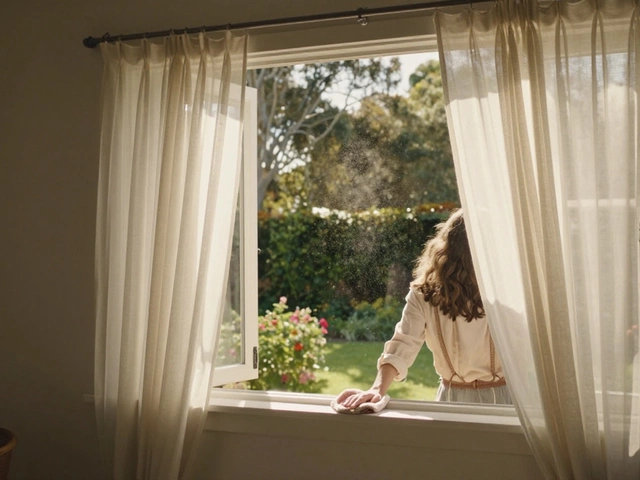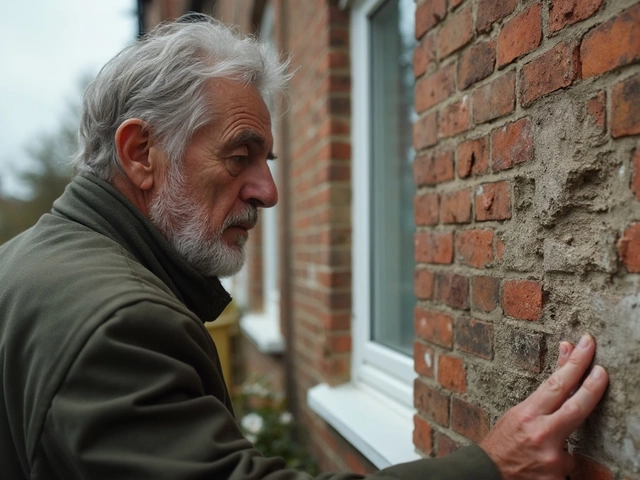Ever stare at a messy house and feel totally overwhelmed? You’re not alone. The biggest mistake most people make is jumping in without a plan, which ends up making more work for yourself. Crazy thing is, cleaning a messy house is more about the order you do things in than how hard you scrub. If you get the basic sequence down, everything just gets way easier and a lot faster.
Here’s something most pros swear by: always go from top to bottom, and dry to wet. If you dust after you vacuum, you’ll just undo your own work. The same applies if you mop before you clear away crumbs or declutter surfaces—total waste of energy. And yeah, you’ve probably heard it before, but decluttering really does come first. You can’t clean around piles of junk, unless you want stale Doritos under your coffee table for another year.
- Why Order Matters
- The Golden Rule: Top to Bottom
- Declutter Before Scrubbing
- Room-by-Room vs. Task-by-Task
- Time-Saving Tricks and Tools
- How to Keep it Clean
Why Order Matters
A lot of people don’t realize that the order you attack a messy house makes or breaks your cleaning efforts. Think about it: if you start by mopping your floors but then knock dust from the ceiling fan onto the wet floor, you just gave yourself double the work. The right house cleaning order keeps you from backtracking and saves you time and energy.
Here’s the thing—cleaning isn’t just random wiping and vacuuming. There’s a science to getting the most out of your effort. Professional cleaners always work from the top of a room to the bottom, and from dry tasks to wet ones. This stops you from making fresh messes where you already cleaned.
A study by the American Cleaning Institute (look it up if you don’t believe it) found that following a set cleaning order can reduce total cleaning time by up to 40%. That means an afternoon job could actually be done before lunch if you play it smart instead of random.
- Top-to-bottom cleaning prevents dust, crumbs, and hair from ending up where you already cleaned.
- Decluttering first helps you actually see the surfaces you need to clean and stops trips back and forth later on.
- Doing dry tasks before wet ones avoids sticky clumps of dust and hair (seriously, it’s gross if you don’t).
Spraying and scrubbing out of order won’t get you anywhere—except frustrated. When you lock in a good cleaning order, your house actually looks and feels cleaner. Plus, you’ve got more time to do literally anything else. That’s why order matters way more than people think.
The Golden Rule: Top to Bottom
This tip is the foundation of smart house cleaning. If you clean your floors first and then go dust your shelves, guess what? That dust lands right back on your fresh vacuum lines. Professionals and cleaning gurus always say: start at the highest surfaces and move down. Makes sense, right? Gravity does half the work for you.
Kick things off by tackling ceiling cobwebs or light fixtures. Those don’t look dirty until you bump them and see a cloud fall onto your couch. After the ceiling, go for the upper shelves, picture frames, wall art, and windowsills. Move down to tables, countertops, and finally—your floors. This “top to bottom” routine lets you clean up in one swoop without repeating steps.
- Ceiling fans, light fixtures, and vents go first. This is where dust hides, and as soon as you start moving it, it falls everywhere.
- Shelves, bookcases, and cabinets are next. Work your way down, shelf by shelf.
- Windowsills, baseboards, and molding catch a ton of dust—don’t forget these spots.
- Wrap up with vacuuming or mopping the floors. All that dropped dust and dirt gets picked up last.
There’s a reason big hotel chains and cleaning companies have their staff cleaning this way—it saves them tons of time and makes their spaces look spotless fast. A 2023 survey of cleaning pros found that almost 90% said top-to-bottom cleaning order prevents wasted effort and gives the best results in less time.
One bonus tip: keep your cleaning tools in a caddy or bucket so you’re not running up and down stairs or back and forth across the room. The more organized you are, the less time you’ll waste.
Declutter Before Scrubbing
If you jump straight into scrubbing when your place is still packed with random stuff, you’ll just be wiping around piles and making the job twice as long. Grab some trash bags and a laundry basket. Start with the obvious: old food wrappers, empty drink bottles, delivery boxes—get them out of sight. You can’t make real progress if you’re dodging clutter everywhere you look.
Tackling house cleaning is way less stressful when you declutter first. The reason’s simple: every extra thing laying around adds time, and germs love hiding in piles of stuff. According to an often-cited British study, the average home contains around 300,000 items—so yeah, even those unopened mail piles count. If you try to wipe, mop, or vacuum before dealing with junk, you’ll either move it to another room or clean around it, which doesn’t really help anyone.
- Go room by room. Don’t wander off to put things away and then get distracted. Stick to one spot until it’s done.
- Have a sorting system: trash, donate, keep, and ‘deal with later’ for stuff you’re not sure about. But don’t add more than a tiny box for the ‘maybe’ pile, or it’ll never leave.
- Flat surfaces first—tables, countertops, desks. It’s easiest to see progress fast and keeps you motivated.
Pro tip if you’re short on time: grab a laundry basket, toss in anything that doesn’t belong in the room you’re working on, and stash it out of sight until the deep clean’s over. Speed matters, especially during spring cleaning. Less clutter means you can see the dirt and finally get rid of those mystery crumbs under the sofa.

Room-by-Room vs. Task-by-Task
If you want to clean a seriously messy house, you have two main options: the room-by-room method or the task-by-task strategy. They both work, but they each have their own pros and cons. Let’s break it down so you can see what fits you best.
The room-by-room approach means you focus all your energy on one spot to completion before moving on. For example, you deep clean the kitchen top to bottom, then move to the living room, and so on. This is awesome for those of us who need the satisfaction of seeing a totally finished area. You get to actually close the door, breathe, and feel a bit accomplished. If guests pop by or you have to quit halfway, at least some part of the house looks presentable.
The task-by-task strategy is more like what the house cleaning pros do. You do the same task—like dusting, vacuuming, or mopping—across the whole house before moving on to the next. You dust every surface everywhere, then you vacuum all the carpets and floors, then you mop, and so on. Studies from cleaning companies like Merry Maids show this cuts down on wasted motion and saves around 20% of time compared to the room-focused method.
| Method | Best For | Downside | Pro Tip |
|---|---|---|---|
| Room-by-Room | Motivation by visual progress | Can take longer overall | Perfect if you’re easily distracted |
| Task-by-Task | Efficiency, faster total cleanup | Can feel repetitive | Use it for big houses or short deadlines |
Here’s a simple way to test what works: do a room-by-room deep clean on a Saturday, then try task-by-task the next week. See which one leaves you less stressed and with a cleaner house. There’s no one right way, and sometimes you need to mix both, like hitting bathrooms one at a time and then doing floors all together. Either way, focusing on house cleaning habits that match your style is what makes the job feel less brutal. Don’t forget to play your favorite playlist for extra motivation—it really helps.
Time-Saving Tricks and Tools
If you want to make cleaning less painful and actually faster, you’ve got to use the right tricks and grab a few must-have tools. It’s not about fancy gadgets; it’s about being smart with what you have. Here’s what actually works for knocking out a messy house and not wasting your Saturday.
- Microfiber cloths pick up dust way better than old t-shirts or paper towels. They trap dirt instead of just spreading it around, so you’re not stuck going over the same spot twice.
- A cordless vacuum seriously changes the game. No more unplugging to move from room to room, and most models work great on both carpet and hard floors. Plus, they’re lighter, so your back will thank you.
- Use a caddy or even just a basket for your cleaning supplies. That way, you’re not running all over the house for spray or sponges—you’ve got everything on hand as you go.
- If you’re not spot-cleaning stains right away, keep a stain remover pen somewhere obvious. It’s wild how much easier it is to zap carpet or upholstery messes if you catch them fresh.
If you’re all about speed, the pros say to work clockwise around each room—avoid doubling back and missing spots. For floors, do a quick sweep or vacuum before you mop, not after. Feels like a no-brainer, but tons of people skip this and end up with streaky messes.
| Tool | How It Helps |
|---|---|
| Microfiber Cloth | Traps dust and reduces cleaning passes |
| Cordless Vacuum | Smoothly moves from room to room |
| Spray Mop | Quicker floor cleaning, less water used |
| Scrub Brush with Handle | Better leverage for tough spots |
Set a timer for 15-minute bursts if you’re easily distracted. It’s weird how much you can do with a deadline. If your house has gotten really out of hand, try the “5 things rule” in every room: pick up and put away five items before you start cleaning. Less stuff means less scrubbing.
And here’s a simple habit to save future hassle: Keep a roll of trash bags in every main room. You’ll be amazed how much junk you toss instead of just moving it from one spot to another.
How to Keep it Clean
So you finally conquered the house cleaning mountain. The hard part’s done, but how do you make sure your place doesn’t become a disaster zone again? Honestly, maintenance is way easier than you think—but only if you set up the right habits and keep it simple. The best trick is to stop messes before they start building up.
A super effective system is the "10-minute rule." Spend ten minutes every day hitting your biggest trouble spots. It sounds like nothing, but a study from the National Soap and Detergent Association (yep, that’s a thing) found people who did daily mini-cleanups spent 40% less time on spring cleaning marathons. You can set a timer, blast a song, and power through:
- Wipe kitchen counters after every meal
- Tidy up items from surfaces (mail, mugs, chargers)
- Wash dishes right after eating—don’t let them stack
- Do a 5-minute sweep in the living room (remotes, blankets, rogue socks)
Another legit tip: stop clutter at the door. Keep a small basket for keys and mail, and anything random goes straight in so you’re not trailing stuff all over the house. And if you’ve got kids (or roommates), agree on a basic rule like "put it away before you leave the room." It’s shocking how much this simple thing pays off.
When it comes to tidy home goals, some people like to make a weekly checklist. If you’re into lists, pop these on your fridge:
- Laundry every Saturday
- Bathroom wipe-down on Sundays
- Vacuum high-traffic areas twice a week
- Empty fridge of leftovers every Friday
If you like stats, check this out:
| Task | Time (per week) |
|---|---|
| Counters & Surfaces | 35 mins |
| Floors | 25 mins |
| Bathrooms | 20 mins |
| Decluttering | 15 mins |
Total: About 1.5 hours a week. Less than the time for a movie night, and you won’t be overwhelmed when spring cleaning comes around.
And don’t wait for a mess to get epic. As soon as you notice something’s gross or piled up, handle it quick. Basically, if you make tiny actions automatic, your cleaning order never feels like a big deal. You’ll keep your home chill, comfortable, and ready for random guests—or just for yourself.





